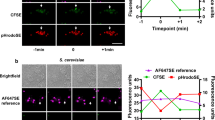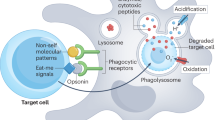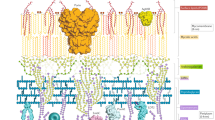Abstract
IT is now clear from many experiments that phagocytic cells can usually degrade dead bacteria, and can sometimes kill live ones, in the absence of any specific immune mechanism. The mechanism of degradation involves the enzymes of lysosomes, which are transferred to the phagocytic vacuoles containing bacteria1. The phagocytes can be activated in various ways, so that their capacity for destruction is increased. Activated phagocytes contain more observable lysosomes and measurable lysosomal enzymes2.
This is a preview of subscription content, access via your institution
Access options
Subscribe to this journal
Receive 51 print issues and online access
$199.00 per year
only $3.90 per issue
Buy this article
- Purchase on Springer Link
- Instant access to full article PDF
Prices may be subject to local taxes which are calculated during checkout
Similar content being viewed by others
References
Allison, A., Sci. Amer., 217, No. 5 62 (1967).
Blanden, R. V., J. Reticuloendothelial Soc., 5, 179 (1968).
Brieger, E. M., and Allen, J. M., in Leprosy in Theory and Practice (edit. by Cochrane, R. G., and Davey, T. F.), second ed., 36 (John Wright, Bristol, 1964).
Cornforth, J. W., Hart, P. D'Arcy, D'arcy Nicholls, G. A., Rees, R. J. W., and Stock, J. A., Brit. J. Pharmacol. Chemother., 10, 73 (1955).
Hart, P. D'Arcy, Science, 162, 686 (1968).
Bitensky, L., in Lysosomes, Ciba Foundation Symp. (edit. by de Reuck, A. V. S., and Cameron, M. P.), 362 (Churchill, London, 1963).
Allison, A. C., and Mallucci, L., J. Exp. Med., 121, 463 (1965).
Hart, P. D'Arcy, and Young, M. R., Stain Technol. (in the press).
Garbutt, E. W., Intern. J. Leprosy, 33, 578 (1965).
Goldfischer, S., J. Histochem. Cytochem., 13, 520 (1965).
Yarborough, D. J., Meyer, O. T., Dannenberg, jun., A. M., and Pearson, B., J. Reticuloendothelial Soc., 4, 390 (1967).
Allen, J. M., Brieger, E. M., and Rees, R. J. W., J. Pathol. Bact., 89, 301 (1965).
Dumont, A., and Sheldon, H., Lab. Invest., 14, 2034 (1965).
Author information
Authors and Affiliations
Rights and permissions
About this article
Cite this article
BROWN, C., DRAPER, P. & HART, P. Mycobacteria and Lysosomes: a Paradox. Nature 221, 658–660 (1969). https://doi.org/10.1038/221658a0
Received:
Issue Date:
DOI: https://doi.org/10.1038/221658a0
This article is cited by
-
A mycobacterial disease is associated with the silent mass mortality of the pen shell Pinna nobilis along the Tyrrhenian coastline of Italy
Scientific Reports (2019)
-
Mycobacterium tuberculosis Exploits a Molecular Off Switch of the Immune System for Intracellular Survival
Scientific Reports (2018)
-
Mycobacterium tuberculosis: here today, and here tomorrow
Nature Reviews Molecular Cell Biology (2001)
-
Intracellular growth of pathogenic mycobacteria in the continuous murine macrophage cell line J-774: Ultrastructure and drug-susceptibility studies
Current Microbiology (1987)
-
Ultrastructural Studies of Paratuberculosis (Johne’s Disease) in Goats
Acta Veterinaria Scandinavica (1981)
Comments
By submitting a comment you agree to abide by our Terms and Community Guidelines. If you find something abusive or that does not comply with our terms or guidelines please flag it as inappropriate.



